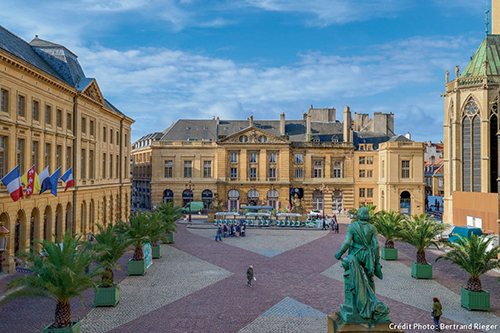
|
|
|
Venue > The conference site
 The Town Hall 1, Place d'Armes 57000 Metz, France - Salon de Guise ACCESS : By Mettis : Ligne A Woippy St Eloy/Stop Republique The Town Hall was built between 1769 and 1771 as part of the development of the Place d'Armes by Blondel. It replaces the Palace of Thirteen, where was previously exercised the municipal power. It is extended by an additional wing between 1785 and 1788 and is therefore the tallest building in the square.Its 92 meters long facade is punctuated by nine arches and two forequarters surmounted by pediments. Before the Revolution, the latter were adorned, respectively, with the arms of the King of France and the City. On the facade, under the inscription "City Hall", one can still see, engraved in the stone, the name of the square in the revolutionary period: "place of the Law".Inside, the entrance overlooks a vast peristyle and a majestic staircase. It is ornated with a superb wrought iron railing and two statues representing Justice and Prudence. On the first floor are several reception rooms, including the lounge of honor, richly decorated. There are medallions representing the illustrious Messins, from the end of the Middle Ages to the middle of the nineteenth century such as: Pilâtre de Rozier, first aeronaut in balloon, Sebastien Le Clerc, engraver of Louis XIV or Antoine Louis, surgeon who put in point the guillotine.Next to the VIP lounge is the Guise Lounge. It is decorated with three windows of Laurent Charles Maréchal, master glassmaker Messin, made in the mid-nineteenth century. They symbolize the three great historical periods of Metz: the left represents the episcopal city with Bishop Bertram, the right one symbolizes the Messina Republic with the master-alderman Baudoche, finally that of the center glorifies the attachment of Metz to the Kingdom of France in 1552, representing the Duke of Guise. As a propaganda measure, it is the most beautiful canopy to show the benefits of this attachment.
|

